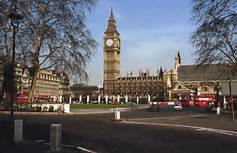Watling Street
Today the V4 is just another of the grid roads that run through Milton Keynes – but it was proably the most important road in British history. It has been the major South East to North West artery for almost 2000 years, perhaps for even longer.
The full route ran from the ports on the English channel. Richborough was the site of the landing during the invasion – and remained a key port, though it was later overtaken in importance by Dover. As previous posts mention, it may have originally crossed the Thames where the Palace of Westminster now stands – but after 50AD when through the new city of London. It was crossed in Leicestershire by the less important SW to NE road from Exeter to Lincoln known as the Fosse Way. There were probably two destinations – Chester and Wroxeter.
The Watling which saw the end of Boudicca’s rebellion took place at some point close to this highway.
In the Saxon period most of it was, briefly, a major frontier – between Anglo-Saxon England and Danelaw. Most of the frontier was on the Watling Street, but at Stony Stratford the boundary left Watling Street and followed the Ouse – so Milton Keynes, east of Watling Street, was an outpost of the English kingdom.
In the Middle Ages it was a key transport route – and it was in this period that Stony Stratford became important. The coaching inns still remain! Until the A5 was diverted through a new grade-separated dual carriageway in our city, what we know as the V4 was a major national trunk route.
A Direct Link to Westminster?
 As noted in the last post, Watling Street ran from the channel ports to Londinium and up through Milton Keynes to Wroxeter and Chester. But was this the original route?
As noted in the last post, Watling Street ran from the channel ports to Londinium and up through Milton Keynes to Wroxeter and Chester. But was this the original route?
Londinium was, like Milton Keynes, a new city (although it had its roots thousands of years beforehand). By 50AD, according to a notice in the Museum of London, the original road was diverted to take in this developing new city. Where did the original route run?
One of the characteristics of Roman roads was that they are remarkably straight. Unlike the later roads which can be notoriously windy, Roman roads joined up points in a straight line. There are of course abrupt changes of direction to avoid some obstacles.
If the road from Dover were continue in a north westerly direction; and the Edgware Road was to follow its path south easterly (rather than abruptly turning eastwards into Oxford Street) they would end up facing each other across the Thames at Westminster.
There has been an oral tradition that the Thames could be crossed by foot at certain times where the Palace of Westminster now stands. Archaeological work (see The royal palace, abbey and town of Westminster on Thorney Island – Museum of London Archaeology Service, 2006) suggests that a sandbank once extended beneath the Palace of Westminster into the then wider & shallower Thames, just to the south of St Stephen’s Chapel (the ‘original’ House of Commons) close to the statue of Richard the Lionheart.
If this thesis is correct we had a direct link to Westminster – via Dunstable; St Albans; the Edgware Road – across Park Lane towards the entrance to Buckingham Palace (the site of Cowford – where the road crossed a branch of the River Tyburn is near to the Victoria Memorial) – across to Tothill Street and along the “ridge” on Thorney Island where Westminster Abbey now stands.
